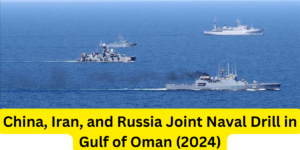China, Iran, and Russia Joint Naval Drill in Gulf of Oman (2024)
Participants:
China, Iran, and Russia have started a coordinated naval practice in the Gulf of Oman. This drill, known as “Marine Security Belt 2024,” incorporates substantial naval forces from each country, including China’s guided-missile destroyer Urumqi and guided-missile frigate Linyi, and Russia’s Varyag, a Slava-class cruiser.
Scope: The drill spans a large region, 17,000 square kilometers of water in the Gulf of Oman, near the Persian Gulf entrance.
Purpose:The collaborative exercise aims to improve marine security, particularly in countering piracy and terrorism, assisting humanitarian efforts, and boosting information exchange for rescue operations. This is the fourth such collaboration between the three countries since 2019.
Additional Participants: While exact specifics are not revealed, other countries are identified as being participants in the “Security Bond-2023” exercises, implying that participation extends beyond the main triad of China, Iran, and Russia. Countries bordering the Gulf of Oman, such as Iran, Pakistan, Oman, and the United Arab Emirates, could be among the participants.
Context and Reaction:
- The practice takes place amid rising tensions between the United States and China, as well as other geopolitical developments.
- The US National Security Council spokeswoman noted that, while the exercise is being monitored, it does not pose a direct danger to US national security interests or those of its regional allies and partners.
- China’s participation in this joint practice is viewed as part of a larger effort to strengthen military and political connections with countries that have strained relations with the United States and its allies.
- China’s mediation efforts with Iran and Saudi Arabia, as well as its sponsorship of discussions between the two countries, demonstrate its expanding position in regional diplomacy.
Iran’s perspective: This drill is part of Iran’s goal to strengthen military cooperation with China and Russia in reaction to regional concerns, particularly those with the United States. It also demonstrates Iran’s ability to maintain security in key waterways such as the Gulf of Oman and the Strait of Hormuz.
Geopolitical Significance: The Gulf of Oman is a strategically vital waterway through which a large amount of world oil commerce flows through the adjacent Strait of Hormuz. The multinational naval drill highlights the region’s changing geopolitical dynamics and the growing role of non-Western states in maritime security matters.
Future ramifications:
The exercise is expected to have larger ramifications for regional security and stability, particularly given the current war in Ukraine and broader geopolitical shifts in global power relations. It also emphasizes the developing nature of military alliances and cooperation in the twenty-first century.




Pingback: Current Affairs – 13 March 2024